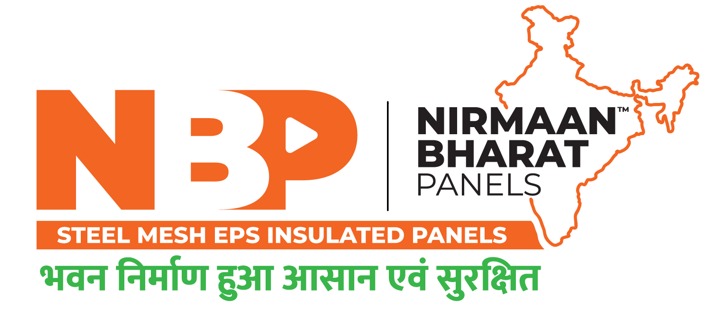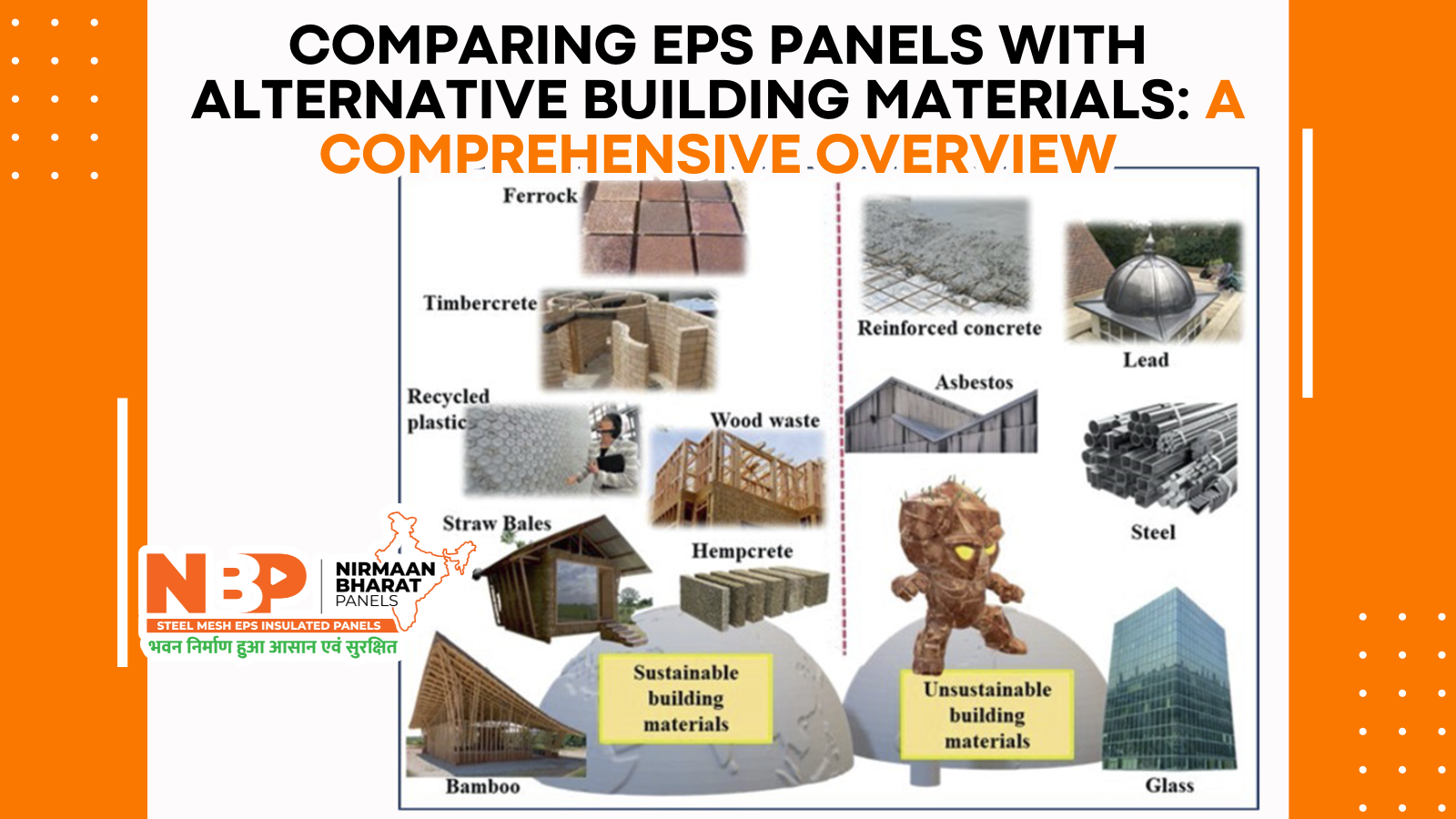Expanded Polystyrene (EPS) panels are a popular construction material known for their superior insulation properties, lightweight nature, and ease of installation. This comprehensive overview compares EPS panels with various alternative building materials across key factors, including performance, cost, environmental impact, and practical considerations.
Table of Contents
Toggle1. Fly Ash Bricks vs. EPS Panels
Material and Composition:
- Fly Ash Bricks: Made from fly ash, cement, and sand.
- EPS Panels: Composed of expanded polystyrene foam sandwiched between layers of cementitious material or plaster.
Advantages:
- Fly Ash Bricks: Eco-friendly, durable, and offer good thermal insulation. They also possess high compressive strength and excellent resistance to weathering.
- EPS Panels: Provide excellent thermal insulation, are lightweight, and are easy to handle. They also offer good acoustic insulation.
Disadvantages:
- Fly Ash Bricks: May require additional plastering for aesthetic finishes and may not be as effective in high-moisture environments.
- EPS Panels: Vulnerable to physical damage, requires protection from UV rays and fire, and may not be as environmentally friendly in the production phase.
Applications:
- Fly Ash Bricks: Suitable for both residential and commercial buildings. Often used in high-density urban areas due to their durability.
- EPS Panels: Ideal for walls, ceilings, and partitioning in residential and commercial buildings. They are often used in modular construction.
Additional Considerations:
- Fly Ash Bricks: Can contribute to LEED certification due to their use of industrial byproducts.
- EPS Panels: Efficient for retrofitting existing buildings due to their lightweight nature.
2. Concrete Blocks vs. EPS Panels
Material and Composition:
- Concrete Blocks: Composed of a mixture of cement, aggregates, and water.
- EPS Panels: Consist of EPS foam with cementitious coatings.
Advantages:
- Concrete Blocks: High strength, durability, and fire resistance. They also offer good soundproofing qualities.
- EPS Panels: Superior insulation properties, lightweight, and enable quick installation. They are also resistant to pests and decay.
Disadvantages:
- Concrete Blocks: Heavier, requires more labor, and offers less effective thermal insulation. They can also be prone to cracking over time.
- EPS Panels: Lower structural strength compared to concrete blocks, and they require careful handling and installation to avoid damage.
Applications:
- Concrete Blocks: Used in structural and non-structural applications, including foundations and load-bearing walls.
- EPS Panels: Used for insulation and partitioning. Also effective in applications where thermal performance is critical.
Additional Considerations:
- Concrete Blocks: More suitable for high-load applications and areas with extreme weather conditions.
- EPS Panels: Ideal for energy-efficient building designs and can be used in combination with other materials for enhanced performance.
3. AAC Blocks vs. EPS Panels
Material and Composition:
- AAC Blocks: Made from a mixture of cement, lime, sand, and aluminum powder, cured under high pressure.
- EPS Panels: Made from EPS foam with cementitious coatings.
Advantages:
- AAC Blocks: Lightweight, good thermal insulation, and fire-resistant. They also have a low thermal conductivity, which contributes to energy savings.
- EPS Panels: Excellent thermal insulation, lightweight, and fast installation. They also offer good moisture resistance.
Disadvantages:
- AAC Blocks: Require precise handling and may be more expensive. They can be brittle and prone to damage if not handled correctly.
- EPS Panels: Lower structural strength and require protection from physical and environmental damage. They may also have limited aesthetic flexibility.
Applications:
- AAC Blocks: Suitable for both load-bearing and non-load-bearing walls in various building types.
- EPS Panels: Ideal for insulating walls, ceilings, and partitions, and can be used in both residential and commercial projects.
Additional Considerations:
- AAC Blocks: Often used in multi-story buildings due to their load-bearing capacity and fire resistance.
- EPS Panels: Useful in modular and prefabricated construction due to their ease of handling and quick installation.
4. Compressed Stabilized Earth Blocks (CSEBs) vs. EPS Panels
Material and Composition:
- CSEBs: Made from soil, cement, and sometimes lime, compressed into blocks.
- EPS Panels: Composed of EPS foam with cementitious coatings.
Advantages:
- CSEBs: Eco-friendly, cost-effective, and provide good thermal mass.They are also highly adaptable in terms of size and shape.
- EPS Panels: Outstanding thermal insulation, lightweight, and straightforward to install. They can be produced with various finishes to meet aesthetic preferences.
Disadvantages:
- CSEBs: Limited in high-rise construction and require curing. They may also have lower compressive strength compared to other materials.
- EPS Panels: Require careful handling and are vulnerable to physical damage and environmental factors.
Applications:
- CSEBs: Suitable for low-cost housing and rural areas where traditional building materials may be scarce.
- EPS Panels: Used for insulation and partitioning in various building types, including residential and commercial structures.
Additional Considerations:
- CSEBs: Can be a sustainable choice for projects focused on local materials and low environmental impact.
- EPS Panels: Effective for enhancing building energy efficiency and reducing overall heating and cooling costs.
5. Rammed Earth vs. EPS Panels
Material and Composition:
- Rammed Earth: Constructed by compacting soil, sand, and stabilizers into walls.
- EPS Panels: Made from EPS foam with cementitious coatings.
Advantages:
- Rammed Earth: Sustainable, offers good thermal mass, and has a low environmental impact. It also provides excellent acoustic insulation.
- EPS Panels: Superior thermal insulation, lightweight, and allows for fast installation. They are also impervious to pests and resistant to rot.
Disadvantages:
- Rammed Earth: Labor-intensive, requires skilled workmanship, and can be less resistant to water unless properly treated.
- EPS Panels: Lower structural strength and require protection from physical damage and environmental factors.
Applications:
- Rammed Earth: Suitable for eco-friendly and sustainable housing projects, especially in regions with abundant soil resources.
- EPS Panels: Ideal for insulation and partitioning in various building types, including retrofitting existing structures.
Additional Considerations:
- Rammed Earth: Offers a natural aesthetic and can be combined with modern construction techniques for enhanced performance.
- EPS Panels: Can be integrated into high-performance building designs to meet energy efficiency standards.
6. Stone Masonry vs. EPS Panels
Material and Composition:
- Stone Masonry: Uses natural stones such as granite, limestone, or sandstone.
- EPS Panels: Made from EPS foam with cementitious coatings.
Advantages:
- Stone Masonry: Highly durable, aesthetically appealing, and low maintenance. It also provides excellent thermal mass and weather resistance.
- EPS Panels: Provides excellent thermal insulation, is lightweight, and easy to install. They also offer good acoustic insulation.
Disadvantages:
- Stone Masonry: Expensive, labor-intensive, and requires skilled masons. It can also be challenging to modify or repair.
- EPS Panels: Lower structural strength, and they need protection from UV and physical damage.
Applications:
- Stone Masonry: Ideal for high-end residential and heritage structures where durability and aesthetics are paramount.
- EPS Panels: Primarily used for insulation and partitioning in both residential and commercial buildings.
Additional Considerations:
- Stone Masonry: Provides long-term value and is often used in landmark or heritage projects.
- EPS Panels: Useful for energy-efficient construction and can be easily incorporated into various building designs.
7. Precast Panels vs. EPS Panels
Material and Composition:
- Precast Panels: Made from concrete, manufactured off-site.
- EPS Panels: Composed of EPS foam with cementitious coatings.
Advantages:
- Precast Panels: High quality, quick installation, and strong. They are also highly customizable in terms of size and finish.
- EPS Panels: Lightweight, offer excellent thermal insulation, and are quick to install. They also allow for easy modification on-site.
Disadvantages:
- Precast Panels: Heavier, require transportation and handling logistics, and can be more expensive.
- EPS Panels: Lower structural strength and are susceptible to physical damage. They also need protection from UV rays and environmental factors.
Applications:
- Precast Panels: Used for walls, floors, and ceilings in various building types, including high-rise and commercial projects.
- EPS Panels: Suitable for insulating walls, ceilings, and partitions, and are effective in modular and prefabricated construction.
Additional Considerations:
- Precast Panels: Offer high precision and quality control, making them suitable for large-scale projects.
- EPS Panels: Can contribute to faster project completion and lower overall construction costs.
8. Straw Bale Construction vs. EPS Panels
Material and Composition:
- Straw Bale Construction: Uses bales of straw covered with plaster or stucco.
- EPS Panels: Made from EPS foam with cementitious coatings.
Advantages:
- Straw Bale: Excellent insulation, sustainable, and low-cost. It also has a low environmental impact and can be locally sourced.
- EPS Panels: Provide superior thermal insulation, are lightweight, and enable quick installation. They also offer good acoustic insulation.
Disadvantages:
- Straw Bale: Requires plastering and is susceptible to pests and moisture if not properly sealed. It may also have limited structural applications.
- EPS Panels: Require careful handling and protection from physical and environmental damage.
Applications:
- Straw Bale: Suitable for eco-friendly housing projects and rural areas where straw is readily available.
- EPS Panels: Ideal for insulation and partitioning in various building types, including residential and commercial structures.
Additional Considerations:
- Straw Bale: Can contribute to sustainability certifications and offer a natural aesthetic.
- EPS Panels: Useful in achieving high energy efficiency standards and reducing heating and cooling costs.
9. Polymer Blocks vs. EPS Panels
Material and Composition:
- Polymer Blocks: Made from polymeric materials combined with aggregates.
- EPS Panels: Composed of EPS foam with cementitious coatings.
Advantages:
- Polymer Blocks: Lightweight, water-resistant, and provide good thermal insulation. They also offer high resistance to moisture and pests.
- EPS Panels: Provide excellent thermal insulation, are lightweight, and easy to handle. They also offer good acoustic insulation.
Disadvantages:
- Polymer Blocks: Can be expensive and may have limited availability. They might also necessitate specialized installation techniques.
- EPS Panels: Lower structural strength and require protection from UV and physical damage. They may also have limited aesthetic flexibility.
Applications:
- Polymer Blocks: Used in various building applications where insulation and light weight are important, such as in modern high-rise buildings.
- EPS Panels: Suitable for insulation and partitioning in residential and commercial buildings.
Additional Considerations:
- Polymer Blocks: Can offer enhanced performance in terms of moisture resistance and thermal insulation.
- EPS Panels: Effective for achieving energy-efficient designs and can be integrated into various building systems.
10. Insulated Concrete Forms (ICFs) vs. EPS Panels
Material and Composition:
- ICFs: Made from styrofoam or similar materials filled with concrete.
- EPS Panels: Made from EPS foam with cementitious coatings.
Advantages:
- ICFs: Provide outstanding insulation, structural strength, and energy efficiency. They also provide good soundproofing and fire resistance.
- EPS Panels: Provide superior thermal insulation, are lightweight, and allow for quick installation. They also offer good acoustic insulation.
Disadvantages:
- ICFs: More expensive and require specific construction techniques. They may also involve complex construction logistics.
- EPS Panels: Lower structural strength compared to ICFs and require protection from physical and environmental damage.
Applications:
- ICFs: Suitable for energy-efficient residential and commercial buildings. They are often used in high-performance and high-durability applications.
- EPS Panels: Ideal for insulation and partitioning, and can be used in various building types, including residential and commercial.
Additional Considerations:
- ICFs: Provide significant long-term energy savings and durability, making them suitable for high-performance building projects.
- EPS Panels: Offer flexibility in design and are effective for achieving energy efficiency in both new constructions and retrofits.
Conclusion
EPS panels offer notable advantages in terms of thermal insulation, weight, and ease of installation compared to traditional and alternative building materials. They are especially effective in improving energy efficiency and reducing overall construction time. However, they may lack the structural strength of some materials and require careful handling and protection. When choosing between EPS wall panels and other materials, consider the specific needs of the project, including structural requirements, budget, environmental impact, and long-term performance. Each material has unique benefits and potential drawbacks, making it crucial to assess their suitability for individual applications and project goals.


